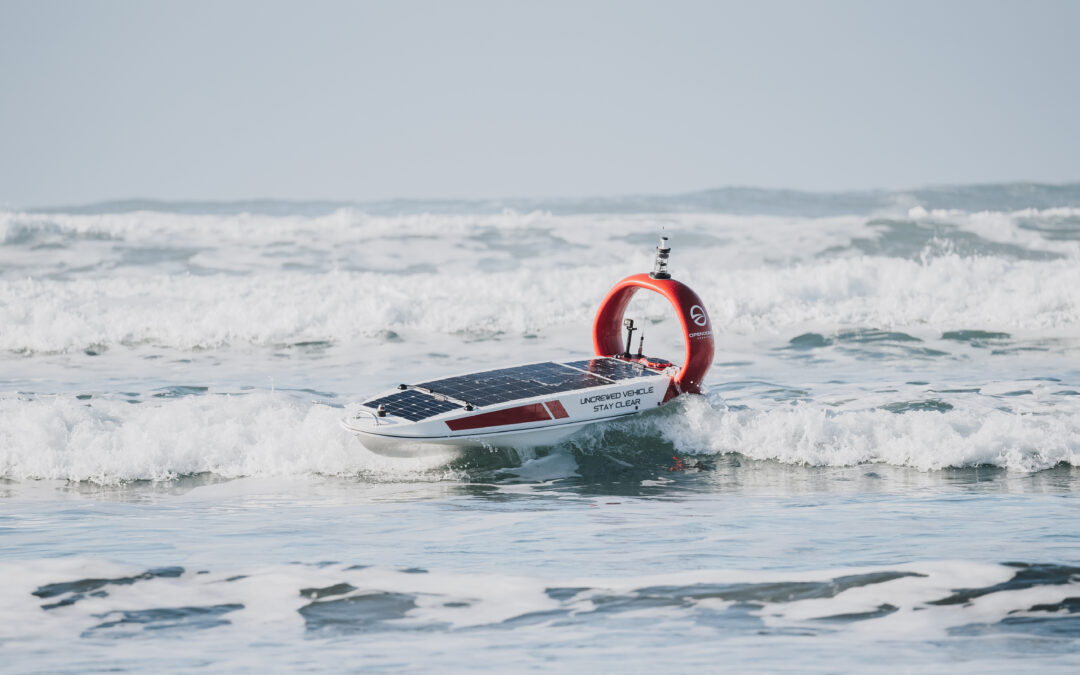
InDro explores USV marine sector – and speaks with a PhD researcher on their work
By Scott Simmie
At InDro Robotics, there’s nothing we love more than research and development.
That shouldn’t be a surprise, because that’s how the company was built. From our early work building and modifying Uncrewed Aerial Vehicles (UAVs) for clients and service provision through to a wide variety of Uncrewed Ground Vehicles (UGVs) we have invented or customised for customers, R&D has always been the heart and soul of InDro. That’s why we have a large and continually scaling team at our Area X.O operations in Ottawa.
We’ve previously done work on the marine side of things and have built and tested Uncrewed Surface Vehicles. Our ‘Talos” USV was remotely piloted and carried a sonar that was deployed via winch. We successfully deployed that on multiple missions, mapping lakebeds and vegetation. Its capabilities were excellent, but our priorities shifted to the aerial and ground side of robotics due to client demands. But we’ve always kept a close eye on marine robotics developments, particularly when it comes to R&D.
There are some really exciting companies in this space in Canada, including Open Ocean Robotics. We are very impressed with its DataXplorer, a solar-powered and self-righting autonomous vehicle suited for long-range data acquisition in the open ocean. It’s a brilliant design, and Co-Founder and CEO Julie Angus is a very impressive individual. With an MSc in Molecular Biology, she’s both a serial entrepreneur and was the first woman to row across the Atlantic Ocean from mainland to mainland. She’s a director on NATO’s Maritime Unmanned System Initiative Innovation Advisory board and was honoured with National Geographic’s Adventurer of the Year award for her trans-Atlantic achievement. Like we said, impressive.
Another company that has caught our attention at conferences is Deep Trekker. It has a solid lineup of ROVs, and we were able to operate its smallest offering at a couple of different trade shows. Recently, it launched an Uncrewed Ground Vehicle that is also submersible. We can see a wide variety of use-cases.
Below: An Open Ocean Robotics video shows off DataXplorer, followed by the InDro Robotics Talos
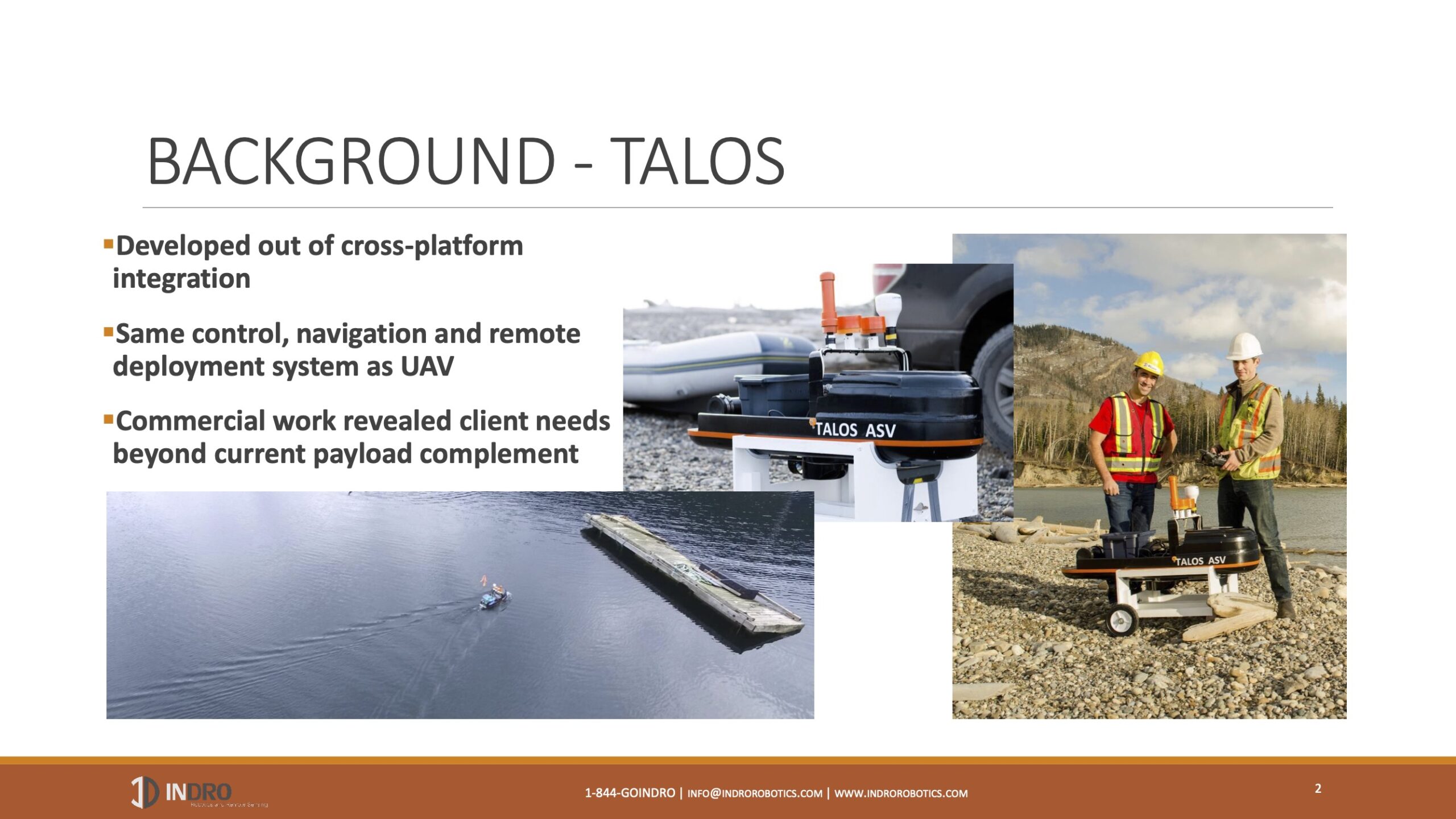
THE R&D FACTOR
Of course, companies can’t create products like these without a significant investment in research and development. This is something we truly understand.
We also know that many innovations have their genesis in a lot of hard work from graduate students and those holding PhDs, who often put in untold hours on projects that can lead to commercial breakthroughs. So we thought it would be enlightening to spend some time talking to one of those people.
We sat down for a chat recently with Thomas Sears, a PhD candidate in Electrical and Computer Engineering with Queen’s University’s Offroad Robotics and Ingenuity Labs Research Institute. He holds a Master of Applied Science in Aerospace Engineering and is a Professional Engineer.
And he’s really, really interested in boats and waves. Specifically, working with USVs to learn more about predicting wave patterns and – ultimately – creating algorithms so that autonomous or pilot-assist systems can anticipate what waves might be coming and how best to orient a boat depending on what those waves are likely to do and the desired outcome.
Sears is a really good explainer. And he started the conversation by talking about humans anticipate and react to waves when they are in the water.
HOW PEOPLE REACT
“As humans when we go to the beach, we can kind of intuitively feel the waves coming and we know, OK, it’s probably four more seconds for another wave,” he says. “How do we give the boat that intuition to know: If I felt a wave here, if I move forward three meters, I’m probably going to feel in four seconds that wave is going to hit me from the side.”
That takes a lot of math, plus a bunch of sensors. But to what end? Is it simply to help ensure a boat might not capsize in rough water?
Well, explains Sears, there are a wide variety of use-case scenarios. Understanding waves, being able to predict them, could for example be of great use to Kingston colleagues who are coastal engineers and study the impact of waves on the coastal environment. A deep understanding of the math and physics involved could be highly useful in predictive models. What’s going to happen to this coastline over time? During a powerful storm?
But there are many other applications. Returning to the human example, Sears points out when a wave is approaching, a human being carries out their own calculations and braces themselves for impact.
“I’d like the boat to be able to do the same thing. If the boat can be out in the water and it can start to notice this trend, whatever the trend is, maybe I can then take an action on that trend,” he says before outlining multiple options for how a boat might respond:
“‘Aha, I’m about to get pushed by the wave.’ Maybe I’d like to surf the wave. Maybe I’d like to push against the wave. Maybe I’d like to turn so I’m safer, whatever that is. That’s sort of for the next person to work on.”
But the work being carried out by Sears will lay the foundation for that next step. He can see, even with an identical set of waves, there might be different optimal autonomous responses depending on the scenario.
“We could see this getting scaled up to crewed vessels…The boat could essentially say: ‘OK, well, we’re worried about passenger comfort.’ Or ‘We’re worried about fuel efficiency’, whatever it (the use-case) is. I’d like to just dial in that option and then the boat can start to go: ‘OK, well, given these wave conditions, here’s how we might want to act.'”
But to get there, you need research, data and predictive models.
“Without the ability to make those predictions of the waves, we have no information to act on. We would just be acting reactively. So we would just say: ‘Oh, I just got hit by a wave, do something quickly’.”
In other words, the boat has to understand what’s coming. And here, things get even more complicated. A boat doesn’t respond immediately to inputs the way an electric car does.
“When you start energizing the motors, it doesn’t move instantly. It starts churning water before something happens. Boats have a bit of a spin-up.”
So that, too, has to be factored into the equation(s) – and would have to be factored into future algorithms suited to specific boats.
“It’s the opportunity to look not just forward in time, but look around the boat for maybe a nicer spot to sit; to let me take an action before the motors are ready to go. So I can I can sort of pre-empt things, which is a sort of a superpower that I’d like to give these boats.”
Below: Thomas Sears with the USV, followed by the USV on a calm day (photos courtesy of Offroad Robotics). YouTube video shows Sears explaining his research
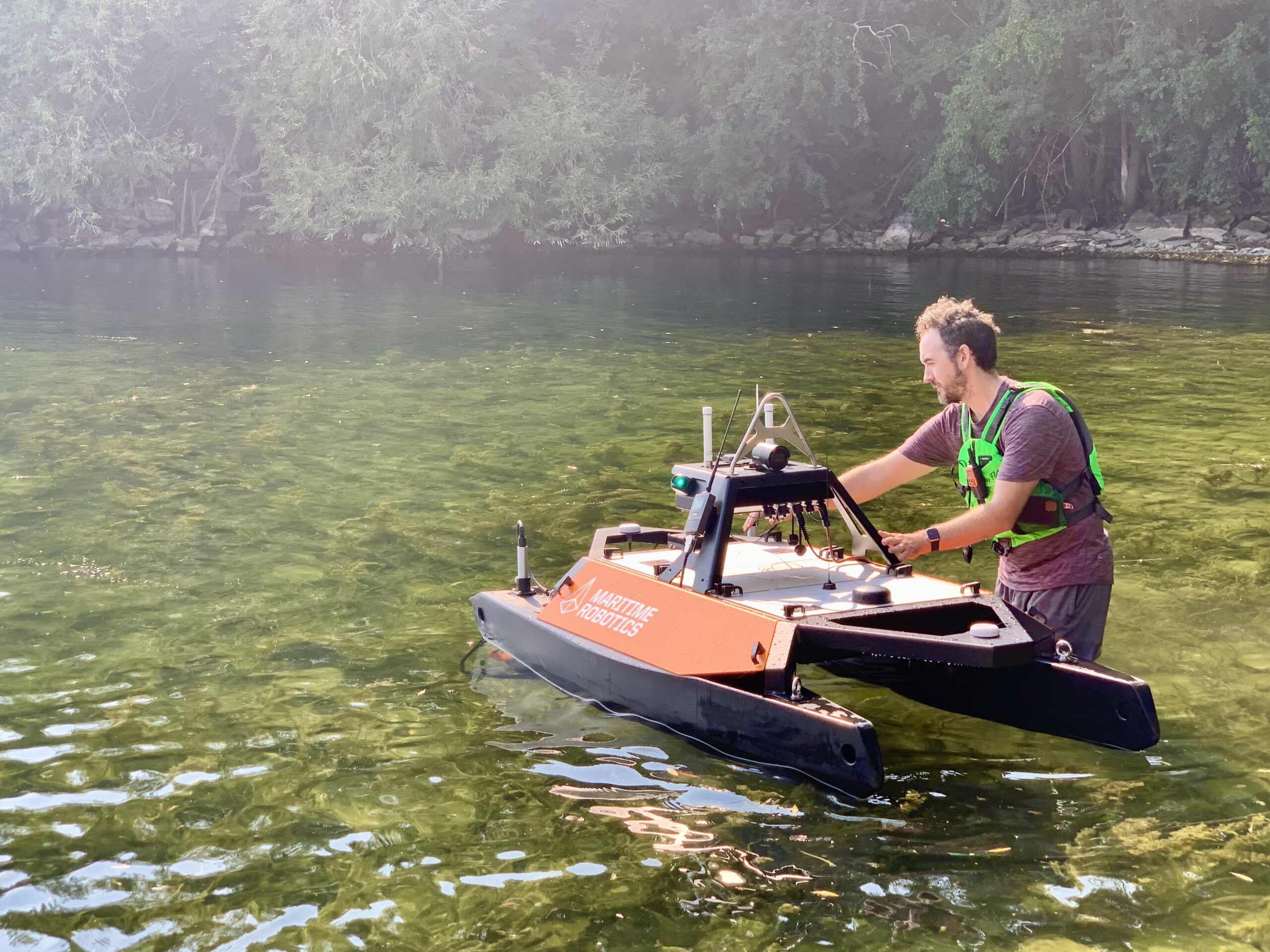
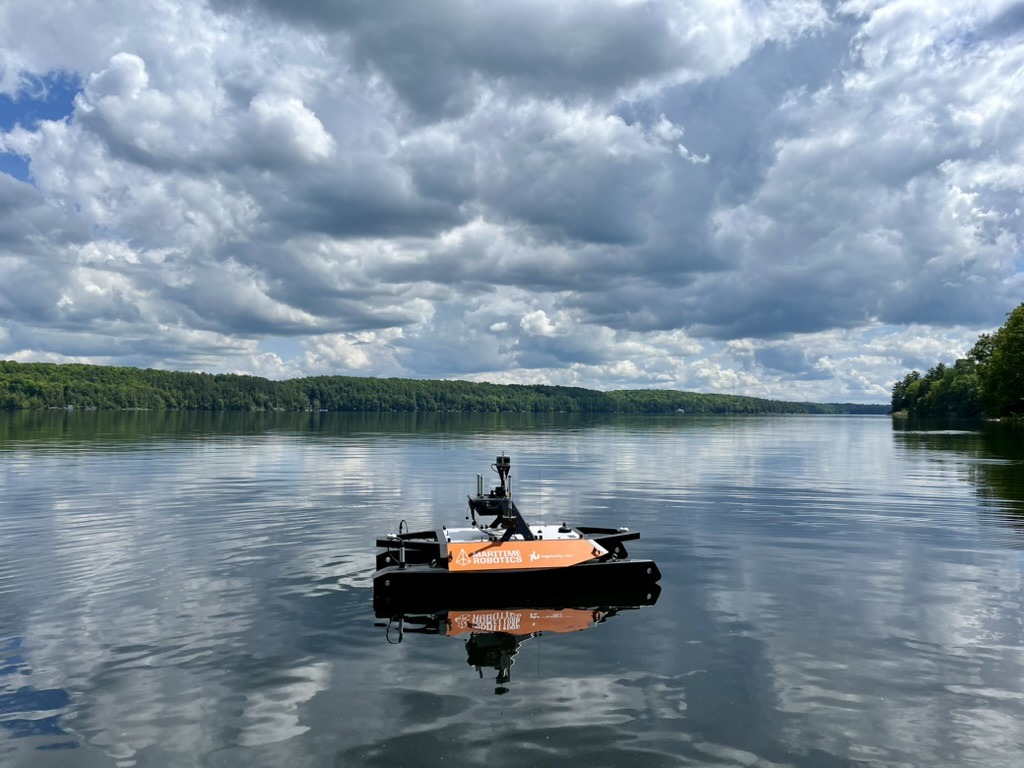
A CUSTOM USV
This is the perfect kind of research for an Uncrewed Surface Vehicle. But to get the right USV took a lot of work from Sears and his team.
They initially were looking for an off-the-shelf USV that would come with most of what they needed. And those needs included the Robot Operating System (ROS) software. They had plans to purchase something from a Canadian robotics company, but it had just ended production on its USV. So they were left with simply finding a base platform and doing all the modifications themselves. Researchers often prefer to put their time into algorithms and R&D rather than building and integration, but that was the option they were left with. Thankfully, with his background in Electrical Engineering this was a task Sears was capable of carrying out.
“The boat that we purchased was not designed for robotics research,” he says. “We had to take on a lot of the non-recurring engineering work of turning it into a research vessel. I’ve been involved in everything from the algorithms that are running on board to picking the computer that is running those algorithms. I happen to come from a background where that’s a comfortable thing for me.”
Doing that work, says Sears, was a “considerable time-sink” – but having a ROS-based platform was critical to the research. They not surprisingly went with ROS 2, the latest iteration of the Robot Operating System. The team actually wrote the interface software themselves, and released it on GitHub.
Then there was the sensor integration: The hardware, the wiring, the software. Plus, of course, making everything waterproof. There was a high performance Inertial Measurement Unit (IMU) and a 16-beam Velodyne LiDAR. It was only when the USV was dispatched that they discovered the LiDAR beams were absorbed by the water. It was, he says, a “weird” thing.
“So unlike our our ground vehicles, where we see the ground, we see the floor, the boat is just floating in nothingness. But the really cool thing is we can leverage that because now if we see something, we know it’s not water. We just see objects – so we don’t have to worry about segmenting out ground and objects.”
That has been particularly useful in research by others using the same USV that involves identifying the coastline. The USV also carries a dual-antenna RTK-enabled GPS receiver.
“That’s critical on a USV platform because you can move sideways on a boat, if the water pushes you sideways, you can move sideways,” he says. “And that fuses with the gyroscope and with the accelerometers on board to give us a really good position measurement.”
For the data to be useful. Sears has to know precisely where the USV is at any given moment – both in terms of its absolute position and its position relative to the waves. There’s also a sonar unit, which is of great use to researchers on the civil engineering side of things. There’s also a camera on board, though Sears laughs that watching its feed is “nausea-inducing.”)
With Queen’s University’s proximity to Lake Ontario, Sears and others can literally launch the USV in about 20 minutes. They also do research inside a wave tank at Queen’s.
THE BIGGER PICTURE
As mentioned, other researchers at the university also capture and analyze data from the USV. All of them have a deep appreciation for the importance of Lake Ontario – and not just as a shipping corridor.
“Lake Ontario is full of life. It’s our source of water for drinking and agriculture, so it needs to be monitored and protected,” says Sears. “Having these water drones watching the lake on our behalf is going to help us ensure that the lake stays healthy, that we stay healthy, that wildlife stays healthy.
“We‘re working toward monitoring this very large space uninhabited by humans that we take for granted in daily life.”
Below: Queen’s University researchers look at data being collected by the USV
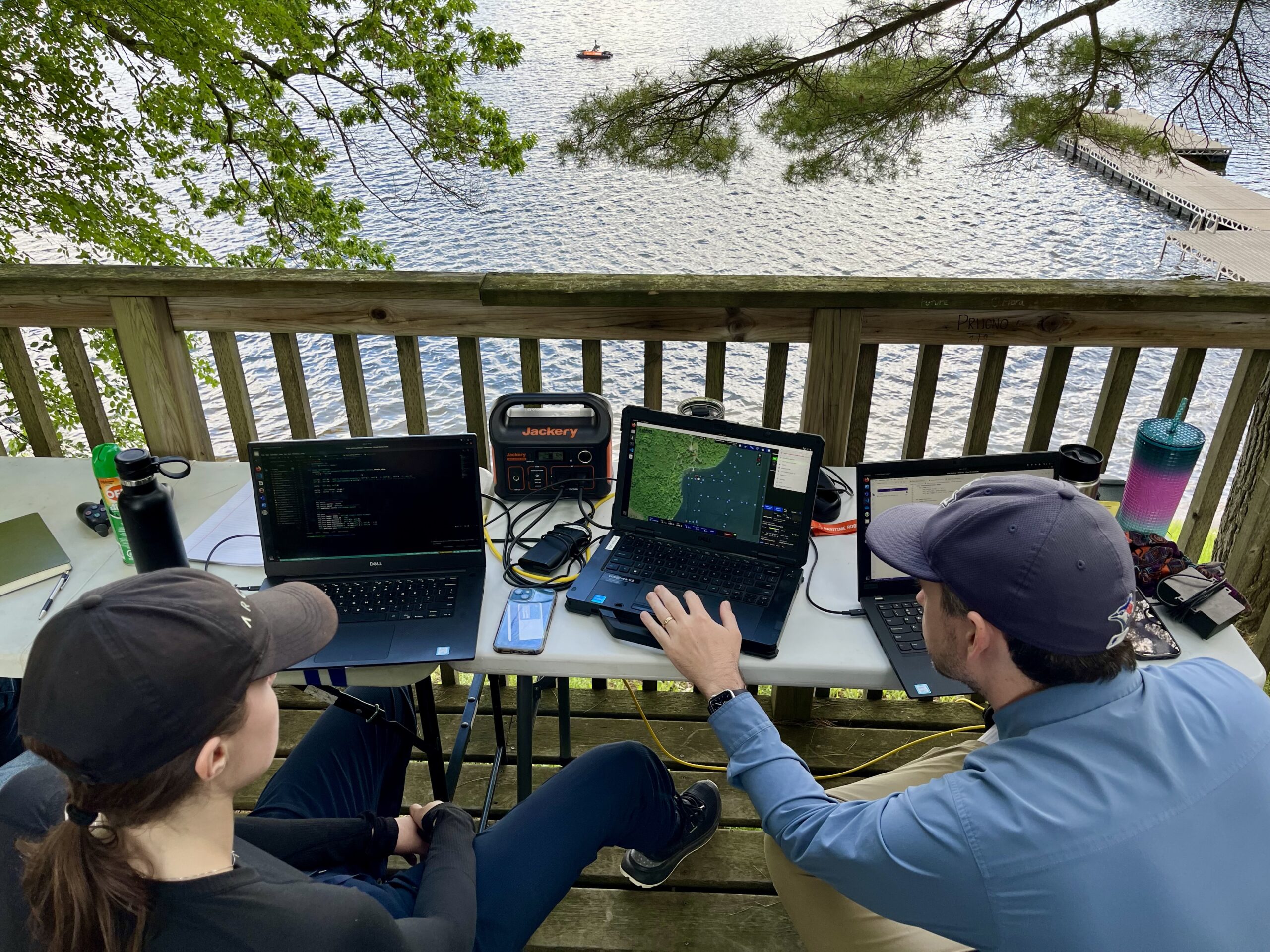
INDRO’S TAKE
Marine robotics are kind of the third leg when it comes to uncrewed vehicles. And, given our reliance on water, a very important one. Our initial vision for InDro Robotics was that we would develop products for all three realms – and we’re still quite proud of our Talos USV.
But during the company’s initial growth we made the decision to put our energy into UAV innovations such as remote teleoperations, deliveries, enhanced service provision and more. (InDro was the first company in Canada to operate UAVs over 4G and 4G, and was the first to obtain a cargo license for drones from the Canadian Transportation Agency, among other firsts). This decision was largely driven by customer demand at the time, as well as our then-startup status.
InDro has now scaled sufficiently that we are once again exploring the marine sector.
“We will have some ROS-based offerings soon that we can customize to enable R&D researchers and commercial clients to carry out complex data acquisition in a marine environment,” says InDro Robotics Founder and CEO Philip Reece. “We’re testing the waters, so to speak, but are optimistic this could be the next sector for our engineers to tackle.”
Already, we have some platforms available that can be used for cleaning surface garbage and cutting aquatic vegetation that’s impinging on the surface. But, like all of InDro’s offerings, these can be customized with additional sensors and teleoperation capabilities based on client needs.
“We have had a mandate since Day One that we want to be experts in unmanned systems,” says Head of R&D Sales Luke Corbeth. “To date, that’s really meant just UAVs and ground robots. But ultimately, we want to be experts on land, air and water. This is our first move into water, and I’m incredibly excited.”
We all are. If you’re interested in our offerings, contact us to learn more.
Feature image at top of story shows the DataXplorer in action; photo courtesy of Open Ocean Robotics
